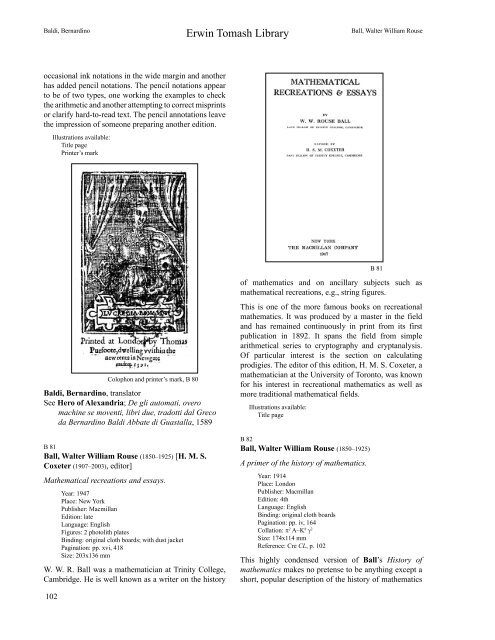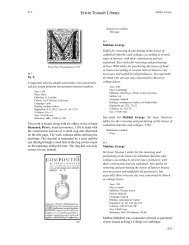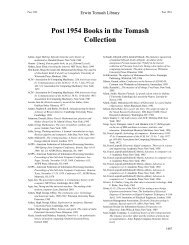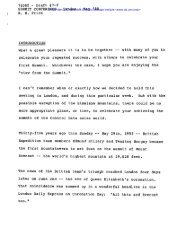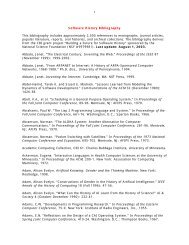B chapter.indd - Charles Babbage Institute - University of Minnesota
B chapter.indd - Charles Babbage Institute - University of Minnesota
B chapter.indd - Charles Babbage Institute - University of Minnesota
You also want an ePaper? Increase the reach of your titles
YUMPU automatically turns print PDFs into web optimized ePapers that Google loves.
102<br />
Colophon and printer’s mark, B 80<br />
Erwin Tomash Library<br />
Baldi, Bernardino Ball, Walter William Rouse<br />
occasional ink notations in the wide margin and another<br />
has added pencil notations. The pencil notations appear<br />
to be <strong>of</strong> two types, one working the examples to check<br />
the arithmetic and another attempting to correct misprints<br />
or clarify hard-to-read text. The pencil annotations leave<br />
the impression <strong>of</strong> someone preparing another edition.<br />
Illustrations available:<br />
Title page<br />
Printer’s mark<br />
Baldi, Bernardino, translator<br />
See Hero <strong>of</strong> Alexandria; De gli automati, overo<br />
machine se moventi, libri due, tradotti dal Greco<br />
da Bernardino Baldi Abbate di Guastalla, 1589<br />
B 81<br />
Ball, Walter William Rouse (1850–1925) [H. M. S.<br />
Coxeter (1907–2003), editor]<br />
Mathematical recreations and essays.<br />
Year: 1947<br />
Place: New York<br />
Publisher: Macmillan<br />
Edition: late<br />
Language: English<br />
Figures: 2 photolith plates<br />
Binding: original cloth boards; with dust jacket<br />
Pagination: pp. xvi, 418<br />
Size: 203x136 mm<br />
W. W. R. Ball was a mathematician at Trinity College,<br />
Cambridge. He is well known as a writer on the history<br />
B 81<br />
<strong>of</strong> mathematics and on ancillary subjects such as<br />
mathematical recreations, e.g., string figures.<br />
This is one <strong>of</strong> the more famous books on recreational<br />
mathematics. It was produced by a master in the field<br />
and has remained continuously in print from its first<br />
publication in 1892. It spans the field from simple<br />
arithmetical series to cryptography and cryptanalysis.<br />
Of particular interest is the section on calculating<br />
prodigies. The editor <strong>of</strong> this edition, H. M. S. Coxeter, a<br />
mathematician at the <strong>University</strong> <strong>of</strong> Toronto, was known<br />
for his interest in recreational mathematics as well as<br />
more traditional mathematical fields.<br />
Illustrations available:<br />
Title page<br />
B 82<br />
Ball, Walter William Rouse (1850–1925)<br />
A primer <strong>of</strong> the history <strong>of</strong> mathematics.<br />
Year: 1914<br />
Place: London<br />
Publisher: Macmillan<br />
Edition: 4th<br />
Language: English<br />
Binding: original cloth boards<br />
Pagination: pp. iv, 164<br />
Collation: π 2 A–K 8 γ 2<br />
Size: 174x114 mm<br />
Reference: Cre CL, p. 102<br />
This highly condensed version <strong>of</strong> Ball’s History <strong>of</strong><br />
mathematics makes no pretense to be anything except a<br />
short, popular description <strong>of</strong> the history <strong>of</strong> mathematics


